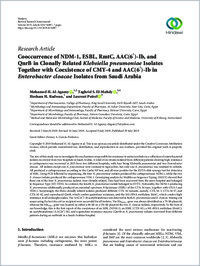Cooccurrence of NDM-1, ESBL, RmtC, AAC(6′)-Ib, and QnrB in Clonally Related Klebsiella pneumoniae Isolates Together with Coexistence of CMY-4 and AAC(6′)-Ib in Enterobacter cloacae Isolates from Saudi Arabia
- Al-Agamy, Mohamed H. Department of Pharmaceutics, College of Pharmacy, King Saud University, 11451 Riyadh 2457, Saudi Arabia - Microbiology and Immunology Department, Faculty of Pharmacy, Al-Azhar University, Nasr City, Cairo, Egypt
- El-Mahdy, Taghrid S. Department of Microbiology and Immunology, Faculty of Pharmacy, Helwan University, Cairo, Egypt - Department of Microbiology, Faculty of Pharmacy, Ahram Canadian University, Cairo, Egypt
- Radwan, Hesham H. Department of Pharmaceutics, College of Pharmacy, King Saud University, 11451 Riyadh 2457, Saudi Arabia
- Poirel, Laurent Medical and Molecular Microbiology Unit, Section of Medicine, Faculty of Science and Medicine, University of Fribourg, Switzerland
-
2019
Published in:
- BioMed Research International. - 2019, vol. 2019, p. 6736897
English
The aim of this study was to investigate the mechanisms responsible for resistance to antimicrobials in a collection of enterobacterial isolates recovered from two hospitals in Saudi Arabia. A total of six strains isolated from different patients showing high resistance to carbapenems was recovered in 2015 from two different hospitals, with four being Klebsiella pneumoniae and two Enterobacter cloacae. All isolates except one K. pneumoniae were resistant to tigecycline, but only one K. pneumoniae was resistant to colistin. All produced a carbapenemase according to the Carba NP test, and all were positive for the EDTA-disk synergy test for detection of MBL. Using PCR followed by sequencing, the four K. pneumoniae isolates produced the carbapenemase NDM-1, while the two E. cloacae isolates produced the carbapenemase VIM-1. Genotyping analysis by Multilocus Sequence Typing (MLST) showed that three out of the four K. pneumoniae isolates were clonally related. They had been recovered from the same hospital and belonged to Sequence Type (ST) ST152. In contrast, the fourth K. pneumoniae isolate belonged to ST572. Noticeably, the NDM-1-producing K. pneumoniae additionally produced an extended-spectrum ß- lactamase (ESBL) of the CTX-M type, together with OXA-1 and TEM-1. Surprisingly, the three clonally related isolates produced different CTX-M variants, namely, CTX-M- 3, CTX-M-57, and CTX-M-82, and coproduced QnrB, which confers quinolone resistance, and the 16S rRNA methylase RmtC, which confers high resistance to all aminoglycosides. The AAC(6′)-Ib acetyltransferase was detected in both K. pneumoniae and E. cloacae. Mating-out assays using Escherichia coli as recipient were successful for all isolates. The Bla NDM-1 gene was always identified on a 70- kb plasmid, whereas the Bla VIM-1 gene was located on either a 60-kb or a 150-kb plasmid the two E. cloacae isolates, respectively. To the best of our knowledge, this is the first report of the coexistence of an MBL (NDM-1), an ESBL (CTX-M), a 16S rRNA methylase (RmtC), an acetyltransferase (AAC[6′]-Ib), and a quinolone resistance enzyme (QnrB) in K. pneumoniae isolates recovered from different patients during an outbreak in a Saudi Arabian hospital.
- Faculty
- Faculté des sciences et de médecine
- Department
- Médecine 3ème année
- Language
-
- English
- Classification
- Biological sciences
- License
-
License undefined
- Identifiers
-
- RERO DOC 327454
- DOI 10.1155/2019/6736897
- Persistent URL
- https://folia.unifr.ch/unifr/documents/308259
Statistics
Document views: 96
File downloads:
- pdf: 167
